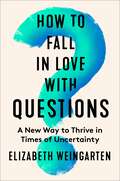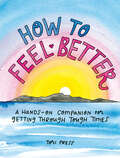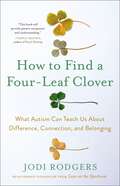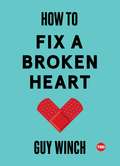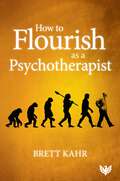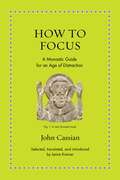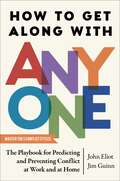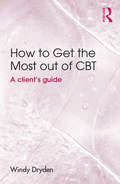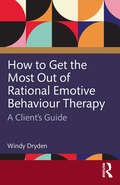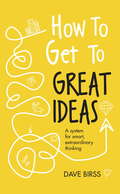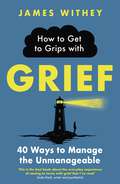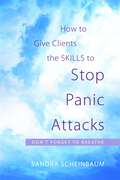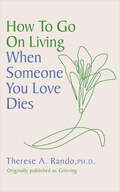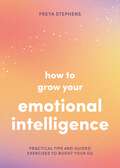- Table View
- List View
How to Fall in Love with Questions: A New Way to Thrive in Times of Uncertainty
by Elizabeth WeingartenJournalist and applied behavioral scientist Elizabeth Weingarten charts a new path to embrace the questions of our lives instead of seeking fast, easy answers.What do you do when faced with a big, important question that keeps you up at night? Many people, understandably, seize answers dispensed by “experts,” influencers, gurus, and more. But these fast, easy, one-size-fits-all solutions often fail to satisfy, and can even cause more pain.What if our questions—the ones we ask about relationships, work, meaning, identity, and purpose—are not our tormentors, but our teachers? Inspired by 150-year-old advice from Austrian poet Rainer Maria Rilke and backed by contemporary science, Elizabeth Weingarten offers a fresh approach for dealing with these seemingly unsolvable questions. In her quest, Weingarten shares her own journey and the stories of many others, whose lives have transformed through a different, and better, relationship with uncertainty.Designed to inspire anyone who feels stuck, powerless, and drained, How to Fall in Love with Questions challenges us to unlock our minds and embark on the kind of self-discovery that’s only possible when we feel most alive—that is, when we don’t know what will happen next.
How to Feel Better: 4 Steps to Self-Coach Your Way to a Happier More Authentic You
by Ruth KudziWhen we feel broken we look to be fixed, we consume books, have therapy, diet, whatever it takes! BUT true self development is not about being 'fixed' it's about accepting the parts of yourself and then enhancing who we already are.Focusing on evidence-based approaches, Ruth will teach you how to not just read about, but truly integrate personal development work. She'll take you through 4 key questions that encourage both self-reflection and include action-oriented tasks that will help you create sustainable results.1. What do you want? 2. Where are you now? 3. How do you get to where you want to be? 4. How do you stay there?Ruth started our her personal development journey when studying Psychology as she wanted to know what the f**k was wrong with her: she felt that she was different and wanted to see if there was a scientific reason.Using tools she has developed to help train thousands of coaches, Ruth will help you to create a strong self-coaching mindset, helping you to rewire your brain, so that you can adopt new ways of thinking, feeling and behaving. She draws from a variety of disciplines including neuroscience, positive psychology, somatic and energy work to provide a truly unique self-coaching programme that is totally results focused.
How to Feel Better: A Hands-On Companion for Getting Through Tough Times
by Tori PressAn illustrated guide to the life-changing practice of emotional self-care, by the popular Instagram artist @revelatori.We can&’t control life&’s ups and downs—but we can try to make our path a little smoother. In this honest and encouraging guide, popular Instagram artist Tori Press shares daily practices, wry and vulnerable observations, and plenty of ideas to explore on the road to emotional wellness, including reconnecting with nature, simple mindfulness exercises, and a beginner&’s guide to the mind-expanding experience of talk therapy. Whether you&’re coping with anxiety, depression, grief, or simply the uncertainties of life in our chaotic and always-on world, this colorful, practical companion offers validation, support, and encouragement along your journey to a calmer, happier tomorrow.
How to Feel: The Science and Meaning of Touch
by Sushma SubramanianWe are out of touch. Many people fear that we are trapped inside our screens, becoming less in tune with our bodies and losing our connection to the physical world. But the sense of touch has been undervalued since long before the days of digital isolation. Because of deeply rooted beliefs that favor the cerebral over the corporeal, touch is maligned as dirty or sentimental, in contrast with supposedly more elevated modes of perceiving the world.How to Feel explores the scientific, physical, emotional, and cultural aspects of touch, reconnecting us to what is arguably our most important sense. Sushma Subramanian introduces readers to the scientists whose groundbreaking research is underscoring the role of touch in our lives. Through vivid individual stories—a man who lost his sense of touch in his late teens, a woman who experiences touch-emotion synesthesia, her own efforts to become less touch averse—Subramanian explains the science of the somatosensory system and our philosophical beliefs about it. She visits labs that are shaping the textures of objects we use every day, from cereal to synthetic fabrics. The book highlights the growing field of haptics, which is trying to incorporate tactile interactions into devices such as phones that touch us back and prosthetic limbs that can feel. How to Feel offers a new appreciation for a vital but misunderstood sense and how we can use it to live more fully.
How to Fight (Mindfulness Essentials #6)
by Thich Nhat Hanh Jason DeantonisLearn how to relax the bonds of anger, attachment, and delusion through mindfulness and kindness toward ourselves and others.The Mindfulness Essentials series introduces beginners and reminds seasoned practitioners of the essentials of mindfulness practice. This time Nhat Hanh brings his signature clarity, compassion, and humor to the ways we act out in anger, frustration, despair, and delusion. In brief meditations accompanied by whimsical sumi-ink drawings, Thich Nhat Hanh instructs us exactly how to transform our craving and confusion. If we learn to take good care of our suffering, we can help others do the same. How to Fight is pocket-sized with two color original artwork by California artist Jason DeAntonis.
How to Find a Black Cat in a Dark Room: The Psychology of Intuition, Influence, Decision Making and Trust
by Jacob BurakAn inquiry into what it is about our experiences and cultures that brings out the differences and reveals the similarities in us as humans beings, in the vein of Malcolm Gladwell and Daniel Kahneman.Jacob Burak is on a quest to answer the question “are we as human beings, who are separated by different cultures and experiences, similar or different?” Through the lens of behavioural studies, we see how, while our approaches differ and often conflict, we all strive for similar things: love, acceptance, power and understanding. How to Find a Black Cat in a Dark Room offers the latest scientific studies of human behaviour alongside accessible anecdotes to examine the universal human experiences of comparing ourselves to others, the need to belong, the urge to achieve and the anxiety and uncertainty of life itself.More importantly, Burak shows us how, in understanding these behavioural patterns, we learn that we are actually more alike than we are different; that our rivals often make us stronger; and that being trusting can help us live longer. With his inquisitive nature, logical thinking and engaging style, Burak examines whether it is destiny or personality that controls our lives, through intriguing subjects such as: • What are the ten rules for happiness that are entirely under our control? • Why do smart people make stupid mistakes? • What distinguishes bureaucrats and entrepreneurs? • What are the psychological differences between liberals and conservatives? • In what circumstances is it right to surrender our privacy? • Does it pay to trust people?
How to Find a Four-Leaf Clover: What Autism Can Teach Us About Difference, Connection, and Belonging
by Jodi RodgersA powerfully moving read from beloved Love on the Spectrum star and disability rights advocate Jodi Rodgers, sharing lessons from her work within the autistic community that can help create a more inclusive society for us all. In How to Find a Four-Leaf Clover, Jodi Rodgers gives us inspiring, heartwarming stories from her years of experience as a teacher and counselor supporting autistic people. While acknowledging our differences, these stories invite us to expand our empathy and compassion for the neurodivergent people in our lives. Throughout, Rodgers explores the powerful impact of embracing neurodiversity and forming meaningful connections with those around us. Each chapter highlights a different story and an aspect of human behavior, including: How we perceive the world, and our own unique experience of thinking, sensing, and feeling How we communicate our perspective to others, understand one another, and express ourselves How we can better connect with one another With dozens of moving stories, How to Find a Four-Leaf Clover will give readers a deeper understanding of and appreciation for the neurodiverse community around them. Above all, it will inspire a profound sense of belonging, revealing that we&’re much more similar than we think.
How to Fix a Broken Heart (TED Books)
by Dr Guy WinchImagine if we treated broken hearts with the same respect and concern we have for broken arms? Psychologist Guy Winch urges us to rethink the way we deal with emotional pain, offering warm, wise, and witty advice for the broken-hearted.Real heartbreak is unmistakable. We think of nothing else. We feel nothing else. We care about nothing else. Yet while we wouldn&’t expect someone to return to daily activities immediately after suffering a broken limb, heartbroken people are expected to function normally in their lives, despite the emotional pain they feel. Now psychologist Guy Winch imagines how different things would be if we paid more attention to this unique emotion—if only we can understand how heartbreak works, we can begin to fix it. Through compelling research and new scientific studies, Winch reveals how and why heartbreak impacts our brain and our behavior in dramatic and unexpected ways, regardless of our age. Emotional pain lowers our ability to reason, to think creatively, to problem solve, and to function at our best. In How to Fix a Broken Heart he focuses on two types of emotional pain—romantic heartbreak and the heartbreak that results from the loss of a cherished pet. These experiences are both accompanied by severe grief responses, yet they are not deemed as important as, for example, a formal divorce or the loss of a close relative. As a result, we are often deprived of the recognition, support, and compassion afforded to those whose heartbreak is considered more significant. Our heart might be broken, but we do not have to break with it. Winch reveals that recovering from heartbreak always starts with a decision, a determination to move on when our mind is fighting to keep us stuck. We can take control of our lives and our minds and put ourselves on the path to healing. Winch offers a toolkit on how to handle and cope with a broken heart and how to, eventually, move on.
How to Flourish as a Psychotherapist
by Brett KahrHow do you develop a truly rich and rewarding career in psychotherapy? How can you find joy in such painful work? How do you develop your skills in the field? How can you conquer your creative inhibitions? In short, how do you flourish as a psychotherapist? Brett Kahr answers these questions, and so many more, in his brilliant new book, painting a frank portrait of the life of the psychotherapist. Taking the reader through the life cycle of the therapist, Brett offers lots of practical advice, from assessing one's suitability for the career, to managing one's finances, to preparing for death. His clear voice and style shine through in this authentic, readable narrative. Professor Kahr has produced a must-read, gripping account of how you can thrive in every respect in this complex and rewarding career. How to Flourish as a Psychotherapist should be required reading for every therapist, anyone considering taking up the career, and everyone who has ever wondered what kind of person becomes a therapist. This is a truly original work that should become compulsory reading by all in the field.
How to Fly a Horse: The Secret History of Creation, Invention, and Discovery
by Kevin AshtonAs a technology pioneer at MIT and as the leader of three successful start-ups, Kevin Ashton experienced firsthand the all-consuming challenge of creating something new. Now, in a tour-de-force narrative twenty years in the making, Ashton leads us on a journey through humanity's greatest creations to uncover the surprising truth behind who creates and how they do it. From the crystallographer's laboratory where the secrets of DNA were first revealed by a long forgotten woman, to the electromagnetic chamber where the stealth bomber was born on a twenty-five-cent bet, to the Ohio bicycle shop where the Wright brothers set out to "fly a horse," Ashton showcases the seemingly unremarkable individuals, gradual steps, multiple failures, and countless ordinary and usually uncredited acts that lead to our most astounding breakthroughs.Creators, he shows, apply in particular ways the everyday, ordinary thinking of which we are all capable, taking thousands of small steps and working in an endless loop of problem and solution. He examines why innovators meet resistance and how they overcome it, why most organizations stifle creative people, and how the most creative organizations work. Drawing on examples from art, science, business, and invention, from Mozart to the Muppets, Archimedes to Apple, Kandinsky to a can of Coke, How to Fly a Horse is a passionate and immensely rewarding exploration of how "new" comes to be.
How to Focus: A Monastic Guide for an Age of Distraction (Ancient Wisdom for Modern Readers)
by John CassianHow you can learn to focus like a monk without living like oneDistraction isn’t a new problem. We’re also not the first to complain about how hard it is to concentrate. Early Christian monks beat us to it. They had given up everything to focus on God, yet they still struggled to keep the demons of distraction at bay. But rather than surrender to the meandering of their minds, they developed powerful strategies to improve their attention and engagement. How to Focus is an inviting collection of their strikingly relatable insights and advice—frank, funny, sympathetic, and psychologically sophisticated.This wisdom is drawn from John Cassian’s fifth-century CE Collationes, one of the most influential manuals for monks from late antiquity. The Collationes follow Cassian and his friend Germanus as they travel around Egypt, asking a series of sage monks how they can make their minds stronger. In response, these monks offer a range of techniques for increasing focus, including setting goals, training the body, managing the memory, using mantras, taking breaks, consulting others—and, most of all, being honest about yourself. As Cassian and Germanus eventually realize, we can’t escape distraction—but we can learn how to confront it and, eventually, to concentrate.Featuring an engaging new translation by Jamie Kreiner and the original Latin on facing pages, How to Focus can help even the least monkish of us to train our attention on what matters most.
How to Forget: A Daughter’s Memoir
by Kate MulgrewIn this profoundly honest and examined memoir about returning to Iowa to care for her ailing parents, the star of Orange Is the New Black and bestselling author of Born with Teeth takes us on an unexpected journey of loss, betrayal, and the transcendent nature of a daughter’s love for her parents. They say you can’t go home again. But when her father is diagnosed with aggressive lung cancer and her mother with atypical Alzheimer’s, New York-based actress Kate Mulgrew returns to her hometown in Iowa to spend time with her parents and care for them in the time they have left.The months Kate spends with her parents in Dubuque—by turns turbulent, tragic, and joyful—lead her to reflect on each of their lives and how they shaped her own. Those ruminations are transformed when, in the wake of their deaths, Kate uncovers long-kept secrets that challenge her understanding of the unconventional Irish Catholic household in which she was raised.Breathtaking and powerful, laced with the author’s irreverent wit, How to Forget is a considered portrait of a mother and a father, an emotionally powerful memoir that demonstrates how love fuses children and parents, and an honest examination of family, memory, and indelible loss.
How to Get Along with Anyone: The Playbook for Predicting and Preventing Conflict at Work and at Home
by John Eliot Jim GuinnDefuse any heated conflict by learning which of the five conflict styles you are and how to resolve even the most sensitive dispute with this must-read guide.The average American worker spends 156 hours a year engaged in the kind of moderate to intense workplace conflict that adversely impacts both performance and health. Managers spend twenty-six percent of their time addressing and resolving conflicts on their team—the equivalent of chewing up one full workday each week. But what if it didn&’t need to be like this? What if there was a way to spend less time in stressfully interpersonal interactions and more time on the things that really matter? Through three decades of building and facilitating team chemistry for Fortune 500 companies, professional sports franchises, schools, government agencies, nonprofit organizations, and families—Drs. Jim Guinn and John Eliot have reduced the time and cost of conflict resolution. With this on-the-ground experience combined with industry-leading science and research, Guinn and Eliot discovered people respond to conflict in one of five ways: avoid, compete, analyze, collaborate, or accommodate. Because our responses are ingrained byproducts of the subcortex in action, they are predictable. If you can predict how someone will behave in a given circumstance, you can formulate a game plan. The secret is knowing which of the five patterns someone is wired to use when smacked by a stressor. How to Get Along with Anyone is a pragmatic hands-on book to help you determine conflict types so you can navigate the arguments that emerge in day-to-day life. You&’ll learn the formula for identifying your coworkers&’ and loved ones&’ conflict styles and how to use this information to foster better communication and more effective, collaboration. Filled with fun, engaging examples and actionable techniques, How to Get Along with Anyone teaches you how to predict and prevent escalated conflict, arming you with practical tools for flipping the script on sticking points to nurture stronger and more meaningful relationships.
How to Get Kids Offline, Outdoors, and Connecting with Nature: 200+ Creative activities to encourage self-esteem, mindfulness, and wellbeing
by Bonnie ThomasFull of ideas, activities and exercises, this book provides imaginative ways to inspire young people to put down the computer games, disconnect from social media, and spend more time away from a screen. In an increasingly electronic world, creating enthusiasm for the great outdoors can seem an impossible task. Yet, the benefits of nature are endless, and they extend further than just improving physical health; being in natural surroundings is also an effective way to boost imagination, creativity and overall wellbeing. In whatever capacity you work or care for children and young people, this book will help you motivate them to reboot their connection with nature and become healthier for it. Addressing how nature-based activities can be used for improved mental health, this book will be an invaluable addition to the library of any professional who works with young people including counselors, educators, youth group workers, social workers, and childcare providers. It is also a useful resource for parents.
How to Get the Most Out of CBT: A client's guide
by Windy DrydenHow to Get the Most Out of Cognitive Behaviour Therapy (CBT): A client’s guide is aimed at those who are either considering consulting a cognitive behaviour therapist or who are actually consulting such a therapist. Written by one of the world’s leading CBT practitioners, it will steer you through the CBT process. The guide will help you to decide whether CBT is right for you, give you advice about how to make a therapeutic agreement with a therapist, show you how to prepare for CBT sessions and how to apply what you have learned from CBT after therapy has ended. How to Get the Most Out of Cognitive Behaviour Therapy (CBT) is a concise and practical guide that will help you to understand the CBT process and how to make the most of your therapy, no matter which CBT approach your therapist practises, so that you continue to benefit from it once therapy has ended and can learn to be your own therapist.
How to Get the Most Out of Rational Emotive Behaviour Therapy: A Client’s Guide
by Windy DrydenHow to Get the Most Out of Rational-Emotive Behaviour Therapy (REBT): A Client’s Guide is aimed at those who are either considering consulting or already seeing a Rational Emotive Behaviour Therapy (REBT) therapist.This book is designed to help guide clients through the REBT process from before they start through to when they are looking towards an end of therapy and next steps. The goal is not to discuss specific REBT practice methods, but rather provide a comprehensive guide to topics such as: How to decide if REBT is right for you How to prepare for your REBT session Understanding the process of change in REBT Learning to apply what you learn from REBT Therapy Sessions This concise and practical guide will help you to understand REBT, how to get the most out of each session and how you can ensure that you continue to benefit from it once therapy has ended.
How to Get to Great Ideas: A system for smart, extraordinary thinking
by Dave BirssThe highly practical lessons in How to Get to Great Ideas are based on neuroscience, psychology and sociology. Written by former advertising creative director Dave Birss, this book offers a brilliant new system for conceiving original and valuable ideas. It looks at how to frame a problem, how to push your thinking, how to sell the idea, how to build support for it and how to inspire others to have great ideas. It proves that any organization - and any individual or department within an organization - can create a fertile environment for ideas. Combining a practical research-based system with fascinating insights and inspiring and humorous writing, the book also includes the problem-solving system RIGHT Thinking. This is a tool which enables a more effective way to generate more effective ideas, and is one that anyone can use to transform themselves or their business. Training on this system is also available in person from the author. And will be released soon as an online course.
How to Get to Grips with Grief: 40 Ways to Manage the Unmanageable
by James WitheyThis book is for anyone who has lost someone. It may have been recently, or it may have been years ago, but still it stings like it was yesterday. James Withey has known the grief beast since he was five, when his dad died, and it has followed him ever since. In his twenty years supporting people with their own grief, as a counsellor and social care worker, he has helped others work through their despair and reconcile the injustice of grief. With his trademark humour and warmth, he provides forty ways to help you live with and manage your grief no matter what stage you're at. It provides comfort for when it all gets too much, ideas for when you feel at a loss for what to do and more than a laugh or two to balance out the sadness.
How to Get to Grips with Grief: 40 Ways to Manage the Unmanageable
by James WitheyThis book is for anyone who has lost someone. It may have been recently, or it may have been years ago, but still it stings like it was yesterday. James Withey has known the grief beast since he was five, when his dad died, and it has followed him ever since. In his twenty years supporting people with their own grief, as a counsellor and social care worker, he has helped others work through their despair and reconcile the injustice of grief. With his trademark humour and warmth, he provides forty ways to help you live with and manage your grief no matter what stage you're at. It provides comfort for when it all gets too much, ideas for when you feel at a loss for what to do and more than a laugh or two to balance out the sadness.
How to Get to Grips with Grief: 40 Ways to Manage the Unmanageable
by James WitheyThis book is for anyone who has lost someone. It may have been recently, or it may have been years ago, but still it stings like it was yesterday. James Withey has known the grief beast since he was five, when his dad died, and it has followed him ever since. In his twenty years supporting people with their own grief, as a counsellor and social care worker, he has helped others work through their despair and reconcile the injustice of grief. With his trademark humour and warmth, he provides forty ways to help you live with and manage your grief no matter what stage you're at. It provides comfort for when it all gets too much, ideas for when you feel at a loss for what to do and more than a laugh or two to balance out the sadness.
How to Give Clients the Skills to Stop Panic Attacks: Don't Forget to Breathe
by Sandra ScheinbaumHow to Give Clients the Skills to Stop Panic Attacks shows how it is possible to prevent and abort a panic attack through lifestyle change and mind-body relaxation. Presenting an effective approach rooted in the philosophy of functional medicine, this book proposes using calming breathing techniques as the foundation to controlling the anxiety that causes panic. Breathing is then combined with positive imagery, rational thinking, body awareness, nutrition and yoga to provide further support for sparking the real, positive change in clients that will guide them along the road to recovery. The practical tools, step-by-step exercises and motivational scripts within this book will provide an incomparable resource for mental health professionals, psychologists, counselors, and coaches.
How to Go On Living When Someone You Loves Dies
by Therese A. RandoLiving Life While Navigating the Death of a Loved One If you recently lost a loved one, How To Go On Living When Someone You Love Dies is the lifeline you are seeking. Dr. Therese A. Rando’s compassionate and comprehensive guide will help you navigate the storm and find your way back to solid ground. Whether dealing with sudden loss or mourning a long-anticipated passing, this book acknowledges that each person’s journey through grief is unique. It equips its listeners with the tools to understand and address their grief, communicate with children about death, attend to any unfinished business, and find support and other resources to help them move forward with their lives. Dr. Rando emphasizes the importance of self-care and encourages the acceptance of appropriate help and support from others. She provides practical strategies for managing grief during difficult times like the holidays, for planning funerals, and for creating meaningful personal rituals. First published in the late 1980s, Dr. Rando’s book is an enduring guide to the psychological, social, physical, spiritual, and practical aspects of loss. With decades of clinical experience and international acclaim, she is a leading expert on the grieving process. While this guide is intended for people who have lost a loved one, it is also a resource for carers, or anyone else, who wish to support someone navigating the path of bereavement. In the face of loss, this book is not just about surviving, but about living—truly and fully.
How to Go to Therapy
by Carl ShermanHow do you choose among hundreds of available therapies--offered by psychiatrists, psychologists, social workers, and counselors--to help you conquer painful feelings, unbearable anxiety, dysfunctional relationships, or out-of-control behavior? What are the sessions like? How will you know if your therapy is working and when it is time to stop? Veteran medical journalist Carl Sherman gives you the tools to make smart decisions about getting professional help.
How to Grow Your Emotional Intelligence: Practical Tips and Guided Exercises to Boost Your EQ
by Summersdale PublishersLearn how to manage your emotions and improve your people skills with this book, which is bursting with advice on emotional intelligence and how to harness itHow to Grow Your Emotional Intelligence is a practical guide filled with tips to help you hone your skills in the four key areas of emotional intelligence.
How to Handle Pressure
by Clyde M. Narramore Ruth E. NarramoreBack Cover: "pressure seems to be an unavoidable element of modern-day life. We can't escape it. In fact, many of us have not learned to cope successfully with the variety of pressures that come our way. In this book the Narramores suggest practical solutions for Christians seeking to handle pressure. They discuss such issues as time and money management, physical fitness, setting realistic goals, having a confidant to share our burdens, and living an organized life. These pave the way to peace of mind and contented living." Unlike other books of this genre, the Narramores integrate their psychology within a Christian worldview by quoting scripture references and referring to Biblical concepts from both the Old and New Testament. However, because this book has a psychological foundation to it, the non-Christian can gain insights by concentrating on the psychological information and by ignoring the Christian content.
